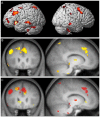The neural correlates of emotional prosody comprehension: disentangling simple from complex emotion
- PMID: 22174872
- PMCID: PMC3236212
- DOI: 10.1371/journal.pone.0028701
The neural correlates of emotional prosody comprehension: disentangling simple from complex emotion
Abstract
Background: Emotional prosody comprehension (EPC), the ability to interpret another person's feelings by listening to their tone of voice, is crucial for effective social communication. Previous studies assessing the neural correlates of EPC have found inconsistent results, particularly regarding the involvement of the medial prefrontal cortex (mPFC). It remained unclear whether the involvement of the mPFC is linked to an increased demand in socio-cognitive components of EPC such as mental state attribution and if basic perceptual processing of EPC can be performed without the contribution of this region.
Methods: fMRI was used to delineate neural activity during the perception of prosodic stimuli conveying simple and complex emotion. Emotional trials in general, as compared to neutral ones, activated a network comprising temporal and lateral frontal brain regions, while complex emotion trials specifically showed an additional involvement of the mPFC, premotor cortex, frontal operculum and left insula.
Conclusion: These results indicate that the mPFC and premotor areas might be associated, but are not crucial to EPC. However, the mPFC supports socio-cognitive skills necessary to interpret complex emotion such as inferring mental states. Additionally, the premotor cortex involvement may reflect the participation of the mirror neuron system for prosody processing particularly of complex emotion.
Conflict of interest statement
Figures


Similar articles
-
What you say versus how you say it: Comparing sentence comprehension and emotional prosody processing using fMRI.Neuroimage. 2020 Apr 1;209:116509. doi: 10.1016/j.neuroimage.2019.116509. Epub 2019 Dec 30. Neuroimage. 2020. PMID: 31899288 Free PMC article.
-
Disentangling the brain networks supporting affective speech comprehension.Neuroimage. 2012 Jul 16;61(4):1255-67. doi: 10.1016/j.neuroimage.2012.03.073. Epub 2012 Mar 30. Neuroimage. 2012. PMID: 22507230
-
fMRI evidence for the effect of verbal complexity on lateralisation of the neural response associated with decoding prosodic emotion.Neuropsychologia. 2008 Oct;46(12):2880-7. doi: 10.1016/j.neuropsychologia.2008.05.024. Epub 2008 Jul 16. Neuropsychologia. 2008. PMID: 18635241
-
Cerebral processing of linguistic and emotional prosody: fMRI studies.Prog Brain Res. 2006;156:249-68. doi: 10.1016/S0079-6123(06)56013-3. Prog Brain Res. 2006. PMID: 17015084 Review.
-
Cortical influences in emotion.J Clin Neurophysiol. 1998 Sep;15(5):409-23. doi: 10.1097/00004691-199809000-00005. J Clin Neurophysiol. 1998. PMID: 9821068 Review.
Cited by
-
Longitudinal change in neural response to vocal emotion in adolescence.Soc Cogn Affect Neurosci. 2022 Oct 3;17(10):890-903. doi: 10.1093/scan/nsac021. Soc Cogn Affect Neurosci. 2022. PMID: 35323933 Free PMC article.
-
Neural systems for evaluating speaker (Un)believability.Hum Brain Mapp. 2017 Jul;38(7):3732-3749. doi: 10.1002/hbm.23630. Epub 2017 Apr 30. Hum Brain Mapp. 2017. PMID: 28462535 Free PMC article.
-
The representation of facial emotion expands from sensory to prefrontal cortex with development.bioRxiv [Preprint]. 2025 May 23:2025.05.23.655726. doi: 10.1101/2025.05.23.655726. bioRxiv. 2025. PMID: 40475683 Free PMC article. Preprint.
-
Dysfunctional cerebello-cerebral network associated with vocal emotion recognition impairments.Cereb Cortex Commun. 2023 Jan 11;4(1):tgad002. doi: 10.1093/texcom/tgad002. eCollection 2023. Cereb Cortex Commun. 2023. PMID: 36726795 Free PMC article.
-
Emotional Prosody Processing in Epilepsy: Some Insights on Brain Reorganization.Front Hum Neurosci. 2018 Mar 13;12:92. doi: 10.3389/fnhum.2018.00092. eCollection 2018. Front Hum Neurosci. 2018. PMID: 29593517 Free PMC article. Review.
References
-
- Belin P, Fecteau S, Bedard C. Thinking the voice: neural correlates of voice perception. Trends in Cognitive Sciences, 2004. 2004;8(3):129–35. - PubMed
-
- Beatty WW, Orbelo DM, Sorocco KH, Ross ED. Comprehension of affective prosody in multiple sclerosis. Multiple Sclerosis. 2003;9(2):148–53. - PubMed
-
- Chakrabarti B, Baron-Cohen S. Empathizing: neurocognitive developmental mechanisms and individual differences. Prog Brain Res. 2006;156:403–17. - PubMed
-
- Ekman P. Are there basic emotions? Psychological Rev. 1992;99(3):550–3. - PubMed
-
- Zinck A. Self-referential emotions. Consciousness and Cognition. 2008;17(2):496–505. - PubMed
MeSH terms
LinkOut - more resources
Full Text Sources

